![]()
![]()
![]()
Use LEFT and RIGHT arrow keys to navigate between flashcards;
Use UP and DOWN arrow keys to flip the card;
H to show hint;
A reads text to speech;
96 Cards in this Set
- Front
- Back
|
Phylogeny of kingdom fungi
|
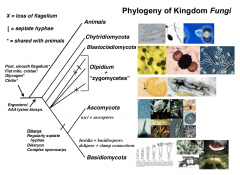
Memorize the attached phylogenetic tree
|
|
|
Ascomycota
Common characteristics and three subphyla |
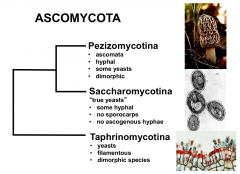
Common characteristics include regularly septate hyphae, a dikaryiotic stage in the life cycle, and sporocarps
Three subphyla include the Pezizomycotina, the Saccharomycotina, and the Taphrinomycotina |
|
|
Pezizomycotina - primary morphological characteristics
|
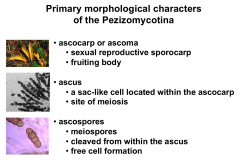
Ascocarp - Fruiting body - Sexual reproductive sporocarp
Ascus - site of meiosis Ascospores - meiospores - cleaved from within the ascus |
|
|
Apothecium
|
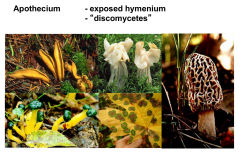
Cup shaped exposed reproductive surface of an ascomycota
Before molecular technique everything that contained an apothecium was classified as 'discomycetes' One of the four main ascomatal types |
|
|
Perithecium
|
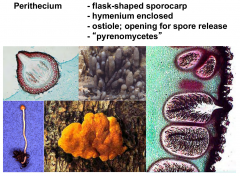
A flask shaped sporocarp, of an ascomycota, which contains hymenium
Ostiole is the term for the canal of the perithecium Before molecular technique everything that contained a perithecium was classified as 'pyrenomycetes' One of the four main ascomatal types |
|
|
Cleistothecium
|
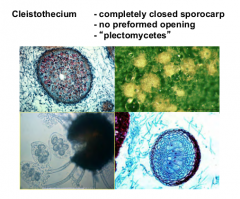
Completely closed sporocarp, of an ascomycota
Before molecular technique everything that contained a cleistothecium was classified as 'plectomycetes' One of the four main ascomatal types |
|
|
Ascostroma (Psuedothecium)
|
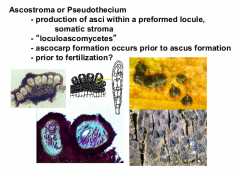
Production of asci within a PREFORMED locule
Ascocarp formation occurs prior to ascus formation Before molecular technique everything that contained a psuedothecium was classified as 'loculoascomycetes' One of the four main ascomatal types |
|
|
The four main ascomatal types
|
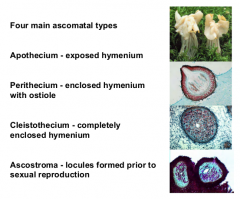
Apothecium - exposed hymenium
Perithecium - enclosed hymenium with ostiole Cleistothecium - completely enclosed hymenium Ascostroma (Psuedothecium) - locules formed prior to sexual reproduction |
|
|
Unitunicate asci
|
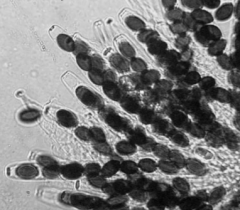
Inoperculate asci with one membrane
|
|
|
Bitunicate asci
|
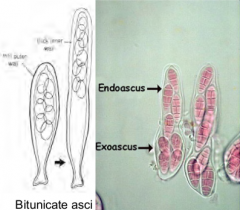
Inoperculate asci with two membranes
|
|
|
Protunicate asci
|
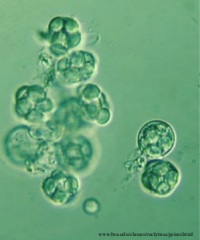
Sphereoid inoperculate asci that release spores by simply degrading
|
|
|
Operculate asci
|
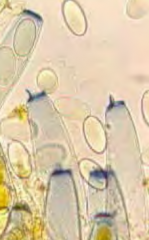
Asci with lids
|
|
|
Inopeculate asci
|
Asci without lids
Includes unitunicate, bitunicate, and prototunicate asci |
|
|
Paraphyses
|
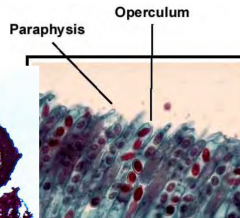
Hyphae growing amongst the asci
Sterile cells associated with the hymenium of Ascomycota |
|
|
Periphyses
|
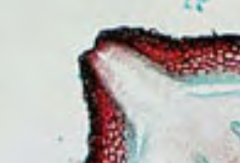
Hyphae in the ostiolar canal of a perithecium
Sterile cells associated with the hymenium of Ascomycota |
|
|
Pseudoparaphyses
|
Originating above the asci of an ascostroma; growing down among the developing asci
Sterile calls associated with the hymenium of Ascomycota |
|
|
Woronin bodies
|
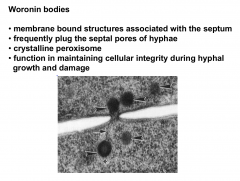
Spherical structures associated with the septum
Woronin bodies will frequently plus the spetal pore of hyphae Function as a shut off value if hyphae are damaged |
|
|
Karyotic states of Ascomycota
|

The vegetative thallus is usually homokaryotic
The dikaryon is restricted to a brief period of sexual reproduction |
|
|
Teleomorph
|
meiotic: asci and ascospores (meiospores)
Propagules are a product of a mating event |
|
|
Anamorph
|
mitotic: mitotic spores (conidia)
Propagules are a genetically identical to mother thallus |
|
|
'deuteromycetes'
|
A former classification of ascomycetes where only the anamorphic stage is known i.e. no sexual mating event has been observed
|
|
|
Three forms of sexual reproduction in Ascomycota
|
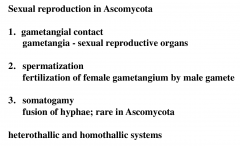
Gametangial contact
Spermatization Somatogamy |
|
|
Ascobolus life cycle
|
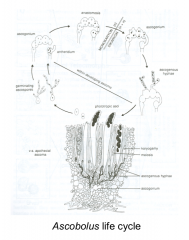
Memorize the life cycle
A good example of gametangial contact of Ascomycota |
|
|
Spermatia
|
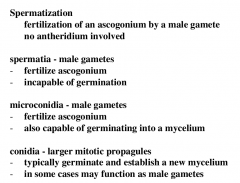
Function as male gametes in spermatization of Ascomycota
Incapable of germination |
|
|
Microconidia
|
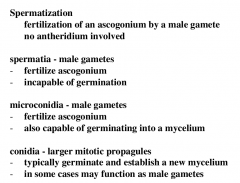
Function of male gametes in spermatization of Ascomycota
Capable of germinating into a mycelium |
|
|
Conidia
|
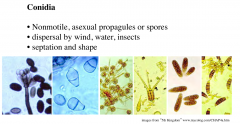
Nonmotile, asxual propagules or spores
Larger mitotic progaules that typically germinate and establish a new mycelium In some cases can function as male gametes in spermatization of Ascomycota |
|
|
Neurospora life cycle
|

Memorize life cycle
Good example of microconidia which can function as a male gamete and germinate into a mycelium |
|
|
Ascosporogenesis
|
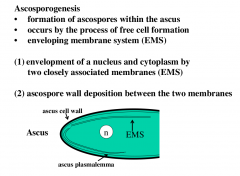
Generates ascospores using an enveloping membrane system
|
|
|
Homogenic incompatibility
|

Inability of genetically similar hyphae to fuse
Controlled by the MAT genes |
|
|
Heterogenic incompatibility
|

Inability og genetically dissimilar hyphae to fuse
Controlled by the HET genes |
|
|
Why would an Ascomycota develop a mitotic reproductive stage to it's life cycle?
|
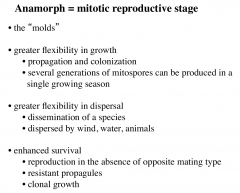
Greater flexibility in growth
Greater flexibility in dispersal Enhanced survival |
|
|
Conidiophore
|

Specialized hyphae
|
|
|
Conidiogenous cell
|

Spore producing cells
|
|
|
Conidium (chain of conidia)
|
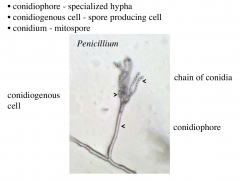
mitospore (s)
|
|
|
Aleuroconidia (aleurospores)
|
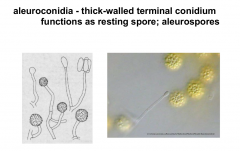
Thick-walled terminal conidium functions as resting spore
|
|
|
Arthrospore
|

Mitotic propagule produced by hyphal fragmentation
|
|
|
Chlamydospore
|

Thick-walled resting spore usually produced from somatic hyphae
Arbuscular mycorrhizae spores are a good example |
|
|
Sclerotium
|
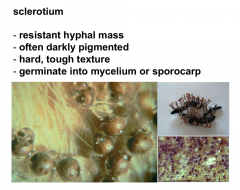
Resistant hyphal mass that will germinate into a mycelium of sporocarp
|
|
|
Loss of sexual reproduction
|

Yields a 'duetoermycetes'
|
|
|
Pleomorphy
|

The ability of a fungus to produce more than one form or type of spore in it's life cycle
|
|
|
Holomorph
|

A fungus and all its expressions
|
|
|
Teleomorphic holomorph
|
meiotic reproduction only
|
|
|
Anamorphic holomorph
|
mitotic reproduction only
|
|
|
Pleomorphic holomorph
|
meiotic and mitotic reproduction, or multiple anamorphs
|
|
|
Ambrosia fungi
|
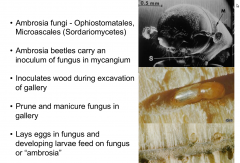
Mutualism between a fungus and a beetle
Ophiostomatales Microascales Cause of dutch elm disease |
|
|
Order: Laboulbeniales
|
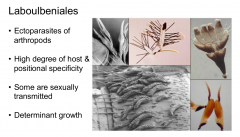
Insect STDs
|
|
|
Infection process of insect pathogens (Cordyceps)
|

Spore adhere to exoskeleton
Germinate Penetration of exoskeleton Grow in yeast-like phase and release toxins Kill host and resume filamentous growth Produce stroma with spores |
|
|
Pezizomycotina - ascomatal types, old clades, asci types
|
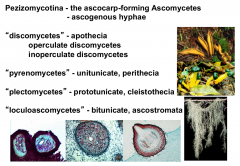
Ascocarp forming ascomycetes with ascogenous hyphae
|
|
|
Genus: Orbilia
|
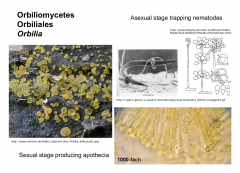
Order: Orbiliales Class: Orbiliomycetes Subphylum: Pezizomycotina Phylum: Ascomycota Kingdom: Fungi
Yellow apothecium on wood, asexual stage are nematode trappers |
|
|
Class: Pezizomycetes
|
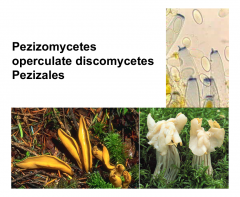
apothecia: ascomatal type
operculate: asci |
|
|
Class: Leotiomycetes
|
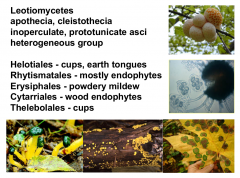
apothecia, and cleistothecia: ascomatal type
inoperculate prototunicate: asci |
|
|
Three classes that contain lichens
|
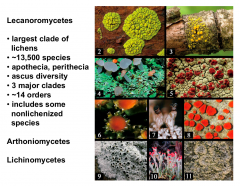
Class: Lecanoromycetes
Class: Arthoniomycetes Class: Lichinomycetes Class: Eurotiomycetes |
|
|
Class: Sordariomycetes
|
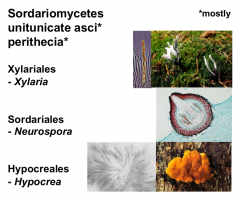
perithecia: ascomatal type
unitunicate: asci |
|
|
Class: Eurotiomycetes
|
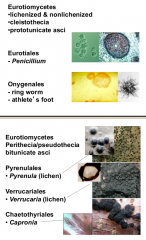
perithecia, pseudothecia, and cleistothecia: ascomatal type
bitunicate and prototunicate: asci |
|
|
Class: Dothideomycetes
|
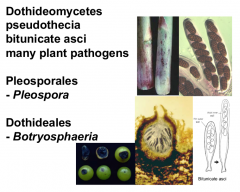
pseudothecia: ascomatal type
bitunicate: asci |
|
|
Subphylum: Taphrinomycotina
|
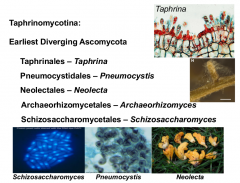
Earliest diverging ascomycota
|
|
|
Subphylum: Saccharomycotina
|
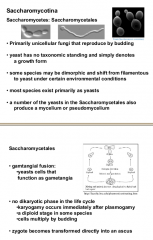
Class: Saccharomycetes Order: Saccharomycetales
The true yeasts Some hyphal No sporocarps No ascogenous hyphae |
|
|
Order: Taphrinales
|
Subphylum: Taphrinomycotina Phylum: Ascomycota
Important group of plant pathogens |
|
|
Yeast asexual reproduction
|
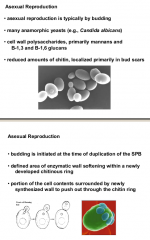
Budding
|
|
|
Saccharomyces cerevisae life cycle
|
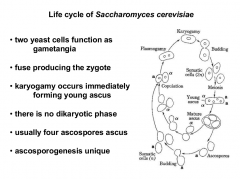
Draw the life cycle
|
|
|
zygomycetes - general characteristics
|
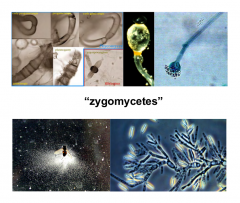
primary colonizers of most substrates
most species have thallus and coenocytic hyphae haploid nuclei in vegetative state chitosan cell walls: glucosamine no flagellated cell posses spindle pole bodies |
|
|
Zygosporangium
|
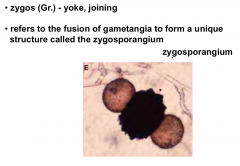
A thick walled structure that results from the gametangial copulation of Rhizpous
|
|
|
zygomycetes - body plan
|

ceoncytic hyphae
rhizoids stolons |
|
|
Sporangiophore
|

Rhizopus asexual reproductive structure
Contains columella, sporangium, and the sporiferous region |
|
|
Rhizopus life cycle
|

Draw the Rhizopus life cycle
|
|
|
Zygophores
|
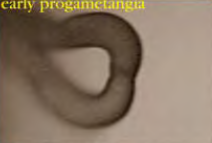
Specialized hyphae of Rhizopus
First stage in Rhizopus mating |
|
|
Fusion septum
|

Forms when two zygophores contact
In rhizpous mating |
|
|
Gametangial septum
|
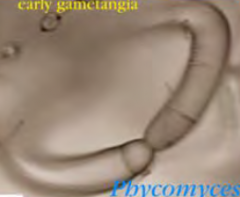
Forms near the tips of the swollen zygophores
Deliniates future gametangia from future suspensor cells Think wrists of the happy Buddha dance In Rhizopus mating |
|
|
Rhizopus mating
|
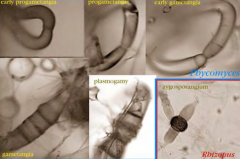
Do the happy Buddha dance!
Zygophores Fusion Septum Swelling of zygophores Gametangial septum Suspensor cells Gametangium Zygosporangium |
|
|
Trisporic acid
|

Hormonal substance responsible for sexual incompatibility in Rhizopus
|
|
|
Pilobolus
|
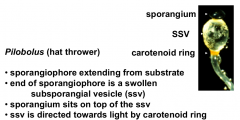
Hat thrower
Carotenoid ring Subsporangial vesicle Sporangium |
|
|
Order: Entomophthorales
|

Class: Zygomycetes
Parasites of insects, some septate mycelium |
|
|
Order: Harpellales
|
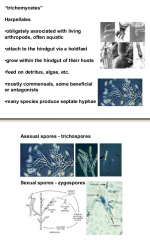
Class: Zygomycetes
Obligate associates with living arthropods They attach to the arthropods with a holdfast 'trichomycetes' |
|
|
'lower fungi'
|
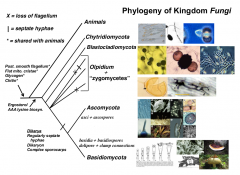
'chytridiomycetes and zygomycetes'
|
|
|
Zoosporic kingdom fungi
|

Chytridiomycota
Blastocladiomycota |
|
|
Genus and Species: Batrachochytrium dendrobatids
|
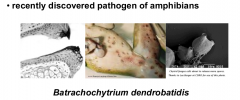
Phylum: Chytridiomycota Order: Chytridiales
Frog killing fungi |
|
|
Chytridiomycota - thallus and life history diversity
|
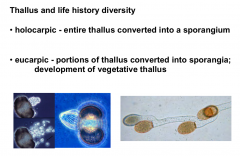
Holocarpic - entire thallus converted into a sporangium
Eucarpic - portions of thallus converted into sporangia; development of the vegetative thallus Unicellular - may produce rhizoids that serve to anchor thallus filamentous - coenocytic mycellium; septa may form at base of reproductive structures |
|
|
Chytridiomycota - flagellated stages of the life cycle
|
zoospores - asexual reproduction
planogametes - sexual reproduction Both zoospores and planogametes produce a single posterior whiplash flagellum |
|
|
Chytridiomycota - asexual reproduction
|
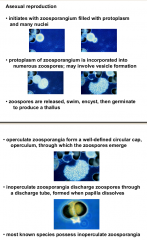
zoosporangium forms
produces zoospores zoospores released, swim, encyst, and then germinate to produce a thallus |
|
|
Chytridiomycota - sexual reproduction
|
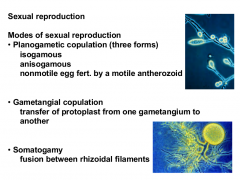
Planogametic copulation - two flagellated gametes meet
Gametangial copulation - gametangia meet Somatogamy - rhizoidal filaments meet |
|
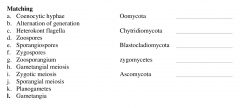
|
Oomycota _________________________________
Chytridiomycota __________________________ Blastocladiomycota _______________________ zygomycota _______________________________ Ascomycota _______________________________ |
|
|
Microbody-lipid globule complex
|

Assemblage of organelles in Chytridiomycota
Functions in utilization of stored lipid and regulation of calcium |
|
|
Genus: Chytriomyces
|
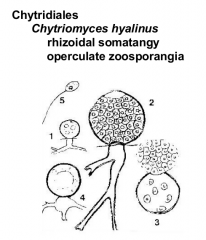
Order: Chytridiales Phylum: Chytridiomycota
Zoosporic stage Sexual mating by way of rhizoidal somatangy Operculate zoosporangia |
|
|
Haplobiontic life cycle
|
One free living thallus
Phylum: Chytridiomycota |
|
|
Diplobiontic life cycle
|
Alternation of generations
Phylum: Blastocladiomycota Genus: Allomyces meiosis is sporangial |
|
|
Allomyces life cycle
|
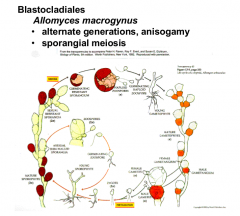
Draw the Allomyces life cycle
|
|
|
Phylum: Blastocladiomycota
|
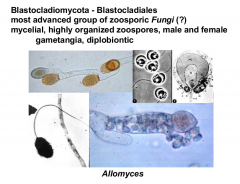
Most advanced zoosporic Fungi
Characterised by a diblobiontic life cycle, male and female gametangia, mycelial, and highly organized zoospores Allomyces is the only example we covered from this phylum |
|
|
Olpidium
|
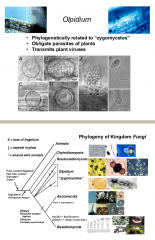
Obligate parasites of plants that transmit plant viruses
Really weird placement in the phylogenetic tree |
|
|
Order: Glomerales - general characteristics
|

coenyctic hyphae
asexual spores olbigate symbionts arbuscular mycorrhizae |
|
|
Arbuscular mycorrhizae - morphological characterisitcs
|

Intracellular hyphae - not infectious
Vesicle - storage sife for fungi Arbuscules - site of nutrient transfer Hyphae in soil - access nutrients Spores in soil - asexual spores ... deuteromycete |
|
|
Arbuscular mycorrhizae - plant and fungal benefits
|
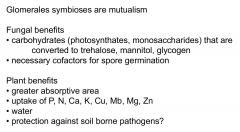
Fungal benefits: carbohydrates, cofactors for germination
Plant benefits: greater absorptive area, increased uptake of nutrients, increased uptake of water, protection against soil born pathogens |
|
|
Order: Saproleginales
|
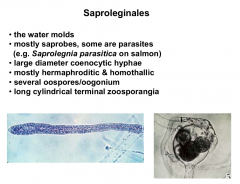
Phylum: Oomycota Supergroup: Stramenopiles
The water molds |
|
|
Saprolegnia life cycle
|
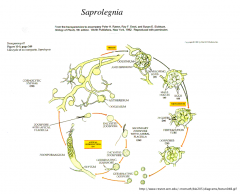
Draw the Saprolegnia life cycle
|
|
|
Order: Pythiales
|
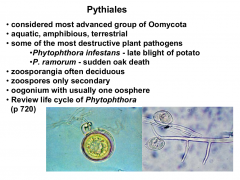
Phylum: Oomycota
Some of the most destructive plant pathogens examples: Phytophthora ramorum, Phytophthora infestans |
|
|
Phytophthora infestans - life cycle
|
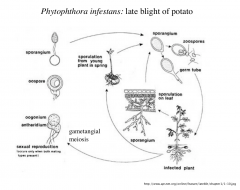
Draw the Phytophthora infestans life cycle
|
|
|
Order: Chytridiales
|
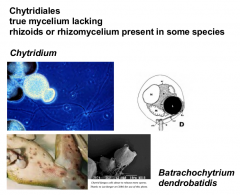
Phylum: Chytridiomycota
true mycelium is lacking rhizoids or rhizomycelium present in some species examples: Chytridium and Batrachochytrium dendrobatidis |

